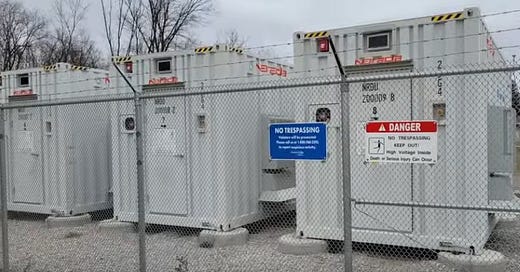On Friday, August 30, Applied Energy Services Corporation (AES), a global utility and power generation company, submitted a proposal to Santa Fe, New Mexico county commissioners to build a 700-acre solar facility with a battery energy storage system (BESS).
On September 5th, a thermal runaway fire started at the AES-built SDG&E (San Diego Gas and Electric) Battery Storage Facility in Escondido, California. (With a thermal runaway fire, excessive heat causes a chemical reaction that spreads to other batteries.) Authorities issued a mandatory evacuation order for the immediate area, and a “shelter in place” order for areas as far as over a mile away from the fire. (To shelter in place, people must go indoors, shut doors and windows and “self-sustain” until emergency personnel provide additional direction.) Schools up to three miles away from the fire were evacuated Thursday and cancelled for Friday. 500 businesses closed.
As of this morning, Saturday, September 7th, officials have not yet lifted orders to evacuate and shelter in place.
On social media, people have reported smelling “burning plastic” inside their homes (despite windows closed) and feeling ill.
People from Oceanside to Encinitas encountered a strong chemical smell starting around 5pm Friday, the 6th. Around 8:30 pm, San Diego County Air Pollution Control District officials said that this smell was not related to the BESS fire in Escondido. Due to the odors’ fleeting nature, they were unable to identify its source.
This is the 3rd AES BESS thermal runaway fire in five years. Officials predict that it could take up to 48 hours to extinguish.
A May, 2024 battery fire in Otay Mesa, California kept firefighters on the scene for nearly 17 days. They sprayed eight million gallons of water on the site. The county’s hazmat team tested water runoff and smoke and reported no toxic or dangerous levels. (Is the key word in this last sentence “reported?”)
For a list of battery energy storage “failure incidents,” see Electric Power Research Institute’s data base. Globally, 63 utility and industrial-scale battery energy storage systems endured failure events from 2011 to 2023. After South Korea, the U.S. has experienced the most major battery energy storage-related fires, with California (six, with this Escondido fire) and New York (four) reporting the most incidents.
Back in Santa Fe County, petitioners emailed and hand-delivered a request to county commissioners on July 23 and August 23 to enact a moratorium on AES’s solar facility and battery energy storage system. Commissioners did not review these petitions before AES submitted its application on August 30th. A moratorium cannot apply to a pending application.
AES’s Escondido Battery Energy Storage facility has 24 BESS battery containers. The corporation plans to install 38 battery containers at its Rancho Viejo BESS facility.
For updates, visit New Mexicans for Responsible Renewable Energy.
Please also read my September 5th post, 21 questions for solar PV explorers and check out Shauna and Harlie Rankin’s video, “Government announces 31 million acre land grab from U.S. ranchers (for solar and wind facilities).” It explains that federal officials and corporations have joined forces to install “renewable power” corridors—five miles wide, 70 miles long, and larger—around the U.S. by 2030. These corridors will cover farm and ranchland with solar and wind facilities.
I also highly recommend Calvin L. Martin’s August, 2019 report, “BESS Bombs: The huge explosive toxic batteries the wind & solar companies are sneaking into your backyard.” Part 1 and Part 2. I recommend reading this report even though powers-that-be removed its videos.
According to basic engineering principle, no technology is safe until proven safe. Will legislators continue to dedicate billions of dollars to subsidizing solar power, wind power, battery storage and EVs? Will commissioners and regulators say, “we have to expect some thermal runaway fires in order to mitigate climate change threats?” Or, will they build safety features into BESS like this firefighter suggests? Will they protect the public and insist on certified reports from liability-carrying professional engineers that all hazards have been mitigated before they permit new facilities and new battery storage systems?





Wow. I'd only heard references to these dangers and incidents, and the land grab was totally new news to me. Thanks for putting this out.
Dear Readers--if you're a (paid or free) subscriber, the email I sent out via Substack to announce this new post deleted its links. The links are still available if you go to my Substack page. Where did the deletions occur??? IF ANYONE HAS INSIGHT ABOUT THIS, PLEASE SHARE.